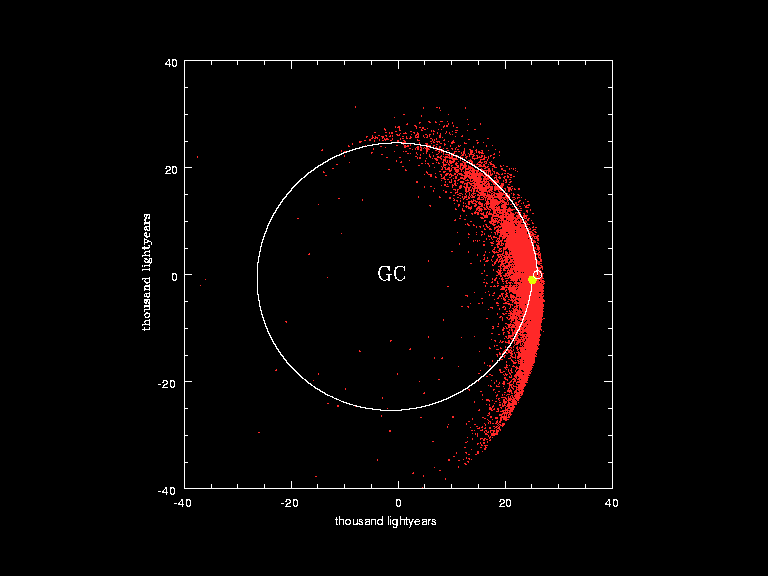Galactic_year
Galactic year
Unit of time
The galactic year, also known as a cosmic year, is the duration of time required for the Sun to orbit once around the center of the Milky Way Galaxy.[1] One galactic year is approximately 225 million Earth years.[2] The Solar System is traveling at an average speed of 230 km/s (828,000 km/h) or 143 mi/s (514,000 mph) within its trajectory around the Galactic Center,[3] a speed at which an object could circumnavigate the Earth's equator in 2 minutes and 54 seconds; that speed corresponds to approximately 1/1300 of the speed of light.
The galactic year provides a conveniently usable unit for depicting cosmic and geological time periods together. By contrast, a "billion-year" scale does not allow for useful discrimination between geologic events, and a "million-year" scale requires some rather large numbers.[4]

The following list assumes that 1 galactic year is 225 million years.
| Time | Event | |
|---|---|---|
| Galactic years (gal) |
Millions of years (Ma) | |
| Past (years ago) | ||
| About 61.32 gal | Big Bang | |
| About 54 gal | Birth of the Milky Way | |
| 20.44 gal | Birth of the Sun | |
| 17–18 gal | 3937 Ma | Oceans appear on Earth |
| 16.889 gal | 3800 Ma | Life begins on Earth |
| 15.555 gal | 3500 Ma | Prokaryotes appear |
| 12 gal | 2700 Ma | Bacteria appear |
| 10 gal | 2250 Ma | Eukaryian period[5][6] first appearance of eukaryotes[7] Stable continents appear |
| 6.8 gal | 1530 Ma | Multicellular organisms appear |
| 2.4 gal | 540 Ma | Cambrian explosion occurs |
| 2 gal | 500 Ma | The first brain structure appears in worms |
| 1.11 gal | 250 Ma | Permian–Triassic extinction event |
| 0.2933 gal | Cretaceous–Paleogene extinction event | |
| 0.0013 gal | Emergence of anatomically modern humans | |
| Future (years from now) | ||
| 0.15 gal | Mean time between impacts of asteroidal bodies in the order of magnitude of the K/Pg impactor has elapsed.[8] | |
| 1 gal | All the continents on Earth may fuse into a supercontinent. Three potential arrangements of this configuration have been dubbed Amasia, Novopangaea, and Pangaea Ultima.[9] | |
| 2–3 gal | Tidal acceleration moves the Moon far enough from Earth that total solar eclipses are no longer possible | |
| 4 gal | Carbon dioxide levels fall to the point at which C4 photosynthesis is no longer possible. Multicellular life dies out[10] | |
| 15 gal | Surface conditions on Earth are comparable to those on Venus today | |
| 22 gal | The Milky Way and Andromeda Galaxy begin to collide | |
| 25 gal | Sun ejects a planetary nebula, leaving behind a white dwarf | |
| 30 gal | The Milky Way and Andromeda complete their merger into a giant elliptical galaxy called Milkomeda or Milkdromeda[11] | |
| 500 gal | The Universe's expansion causes all galaxies beyond the Milky Way's Local Group to disappear beyond the cosmic light horizon, removing them from the observable universe[12] | |
| 2000 gal | Local Group of 47 galaxies[13] coalesces into a single large galaxy[14] | |
- Cosmic Year Archived 2014-04-12 at the Wayback Machine, Fact Guru, University of Ottawa
- Leong, Stacy (2002). "Period of the Sun's Orbit around the Galaxy (Cosmic Year)". The Physics Factbook.
- http://starchild.gsfc.nasa.gov/docs/StarChild/questions/question18.doc NASA – StarChild Question of the Month for February 2000
- El Albani, Abderrazak; Bengtson, Stefan; Canfield, Donald E.; Riboulleau, Armelle; Rollion Bard, Claire; Macchiarelli, Roberto; et al. (2014). "The 2.1 Ga Old Francevillian Biota: Biogenicity, Taphonomy and Biodiversity". PLOS ONE. 9 (6): e99438. Bibcode:2014PLoSO...999438E. doi:10.1371/journal.pone.0099438. PMC 4070892. PMID 24963687.
- El Albani, Abderrazak; Bengtson, Stefan; Canfield, Donald E.; Bekker, Andrey; Macchiarelli, Roberto; Mazurier, Arnaud; Hammarlund, Emma U.; et al. (2010). "Large colonial organisms with coordinated growth in oxygenated environments 2.1 Gyr ago" (PDF). Nature. 466 (7302): 100–104. Bibcode:2010Natur.466..100A. doi:10.1038/nature09166. PMID 20596019. S2CID 4331375.[permanent dead link]
- F. M. Gradstein (2012). The geologic time scale 2012. Volume 2 (1st ed.). Amsterdam: Elsevier. ISBN 978-0-444-59448-8. OCLC 808340848.
- Lunar and Planetary Institute (2010), https://www.lpi.usra.edu/features/chicxulub/
- Williams, Caroline; Nield, Ted (2007-10-17). "Pangaea, the comeback". New Scientist. Retrieved 2014-01-02.
- Franck, S.; Bounama, C.; von Bloh, W. (2005-11-07). "Causes and timing of future biosphere extinction". Biogeosciences Discussions. 2 (6). Copernicus GmbH: 1665-1679. Bibcode:2006BGeo....3...85F. doi:10.5194/bgd-2-1665-2005. S2CID 3619702.
- Cox, T. J.; Loeb, Abraham (2008-05-01). "The collision between the Milky Way and Andromeda". Monthly Notices of the Royal Astronomical Society. 386 (1). Oxford University Press (OUP): 461–474. arXiv:0705.1170. Bibcode:2008MNRAS.386..461C. doi:10.1111/j.1365-2966.2008.13048.x. ISSN 0035-8711. S2CID 14964036.
- Frommert, Hartmut; Kronberg, Christine (2007-06-05). "The Local Group of Galaxies". University of Arizona. Students for the Exploration and Development of Space. Archived from the original on 2009-09-07. Retrieved 2009-10-02.
- Adams, Fred C.; Laughlin, Gregory (1997-04-01). "A dying universe: the long-term fate and evolutionof astrophysical objects". Reviews of Modern Physics. 69 (2): 337–372. arXiv:astro-ph/9701131. Bibcode:1997RvMP...69..337A. doi:10.1103/revmodphys.69.337. ISSN 0034-6861. S2CID 12173790.
- "Milky Way Past Was More Turbulent Than Previously Known". ESO News. European Southern Observatory. 2004-04-06.
After more than 1,000 nights of observations spread over 15 years, they have determined the spatial motions of more than 14,000 solar-like stars residing in the neighbourhood of the Sun.
- "Milky Way Past Was More Turbulent Than Previously Known". ESO News. European Southern Observatory. 2004-04-06.
After more than 1,000 nights of observations spread over 15 years, they have determined the spatial motions of more than 14,000 solar-like stars residing in the neighbourhood of the Sun.
